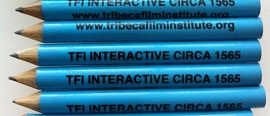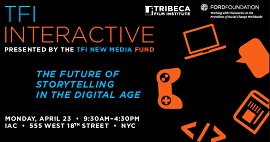
Ironically, these pencils were a big hit at the Tribeca Film Institute's super-high-tech Interactive fest.
Film festivals are tricky events to navigate. Of course they?re about art and commerce and, for some reason, all too many filmmakers are uncomfortable with that combination. Despite the entertainment industry?s craven reputation, there are plenty of people in it ? not just indie movie types ? who long for something pure: complex aesthetic objects that will transport people to new places and new ways of understanding this world and the many alternate realities we?ve crafted for ourselves. That idealism, and the understandable longing for money and attention to achieve that dream, is prominently on display at fests like Tribeca. And yes, a lot of it is about glad-handing and hitting as many cocktail parties as possible (as well as standing next to the right person at the red carpet premieres), but more and more these days, it?s also about figuring out how to make movies do that the networking for you. Filmmakers who?ve managed to crack the social media code have, indeed, mastered the twenty-first century art of networking.
I thought it was terrific that Tribeca devoted an entire day of the Fest to a conference on interactive media. The event was held in Frank Gehry?s gleaming IAC building, in front of an impossibly long wall of screens. The shallow wide room was packed from start to finish with a mix of digerati (I was thrilled to meet Christina Warren?the entertainment editor for Mashable) and people who?ve been toiling in the traditional media trenches all their lives. The implicit goal was to figure out how to make sure that filmmakers learn how to adapt to an increasingly interactive media space ? something more easily said than done. These days, film projects of all sizes are expected to have some sort of online presence, not only for the purpose of promotion but for something far more ephemeral: audience engagement. There are generally no accepted standards to measure the latter, but it usually means that you?ve managed to convince passive potential audience members to take an active role in promoting, extending, or even reimagining the film itself or its subject.
For all too many filmmakers, a transmedia campaign includes a basic formula: a Web site, a Twitter feed, a Facebook page and the coup de grace, an iPhone app. Much to the consternation of app developers like Michelle Byrd from Games for Change, creatives working in traditional media industries often assume that audience engagement just happens on these platforms: as long as you build it, someone will come. But take a quick look at all the apps you?ve installed and don?t use on your phone, and you?ll recognize that even scoring an install doesn?t necessarily lead to one iota of ?engagement.?
Learning how to port linear, narrative art forms over to interactive platforms is a tremendous creative and technical challenge. The danger, of course, in making something interactive, is the often demoralizing loss of creative control. Just about every instinct that a film director, for instance, might have, is best repressed in the development of the types of interactive efforts that characterize current cross-platform outreach campaigns around films. According to panelist Nick Fortugno ? a game designer who worked on The Walking Dead?s interactive materials ? in a game space, you expect some kind of narrative, but it?s more likely that you?ll stumble upon it, rather than experience it as the raison d?etre of the game.

It?s easy to be dismissive about the impact of online campaigns ? after all who has time to download the apps, install the widgets, watch the webisodes, and read the fake Twitter feeds of fictional characters? Well lots of people apparently do (and you?ve probably done some of it, too, though you might not care to admit it). At the Transmedia Hollywood conference, I found out that The Walking Dead?s webisodes attracted six million views in the week before the launch of season 2, exceeding the number of viewers of the TV season premiere itself. It begs the question: at what point will the advertisement or the clever promotional piece eclipse the object that it purportedly promotes?
Part of what The Walking Dead folks did right is that they extended the storytelling of the show as they went about promoting it. They listened to their audience and realized that people wanted more backstory than the TV show had offered on characters like the popular walker ?bicycle girl.? The almost magical result is a happier and more deeply engaged audience, whose time consuming promotional materials was as enjoyable as watching the entertainment they already love.
For people who?ve spent their lives learning how to tell stories to people, it can be tough to figure out how to maintain a dialogue with them. At the TFI Interactive event, program officers from the Ford Foundation and the National Endowment for the Arts encouraged filmmakers to be open to new ways of thinking about human experience. ?Story? is not necessarily where the artist needs to begin or end, argued the NEA?s Alyce Myatt, and Orlando Bagwell emphasized that risk taking and experimenting with new media is essential in the effort to reach larger public audiences ? whether your end-goal is the promotion of a piece of commercial art or profound social change.
As?Ingrid Kopp pointed out, storytellers are in a liminal space right now, where media platforms are rapidly shifting, and the affordances of new technologies continue to catch us by surprise. Even those with several years of experience working in the transmedia arena will testify to how much of a Wild West it remains to be. Steve Coulson, the guy behind the innovative Game of Thrones promotional campaign, gave a terrific presentation on how his team tried to balance the need to engage hard-core fans of the book series and newbies. Coulson?s group went so far as sending gorgeous wooden scent kits to influential fans (the scent vials evoked specific locales in the vast geography of the books), while also developing simple, evocative interactive modules that would allow casual fans to quickly step into the shoes of characters, such as the guards who patrol the 700 foot ice walls in the Northern Territory.
Of course the possibilities for engaging fans in our burgeoning convergence culture are virtually endless. But beyond the bells and whistles and the obvious novelty factor is the tremendous power and appeal of social networking ? the possibility of forging connections among people who have sought out a certain cultural experience ? whether they?re sitting in a movie theater together, standing in line at a Game of Thrones Food Truck event (yes, they did that, too) or exchanging tweets while watching a show in their living rooms. The marketing potential is obvious. The storytelling potential is literally beyond words.
Like this:
One blogger likes this post.
utah jazz lawrence of arabia denver nuggets lakers orioles correspondents dinner i am legend
No comments:
Post a Comment
Note: Only a member of this blog may post a comment.